LÁSZLÓ LAKNER'S EXHIBITION IS ACCOMPANIED BY INTERVENTIONS IN THE PERMANENT EXHIBITION

As of Tuesday, visitors to the Century of Relativity permanent exhibition can expect six new features. These are paintings by Daniel Balabán, Daniel Fischer, Daniel Pitín, Danuta Urbanowicz, Peter Angermann and László Lakner, which will link the permanent exhibition focusing on Central European art of the 20th and 21st centuries with the Infinitum exhibition dedicated to the Hungarian painter László Lakner.
DANIEL BALABÁN
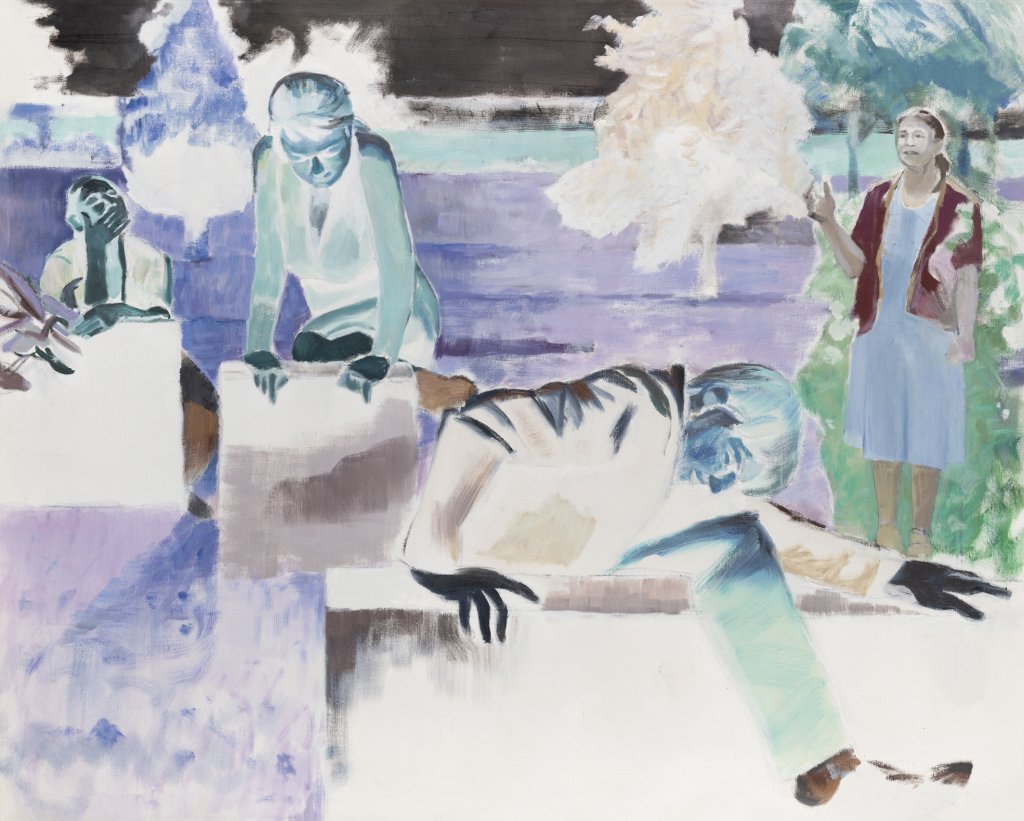
is a Czech painter and university teacher. His uncle was evangelical theologian and clergyman Milan Balabán and his brother was writer Jan Balabán. Since the mid-1980s he has been one of the leading artists of the Ostrava art scene and a coryphaeus of contemporary Czech art in general. He was born in the Moravian town of Šumperk, but has lived permanently in Ostrava since 1962. Between 1979 and 1984, he studied in the painting studio of Professor František Jiroudek at the Academy of Fine Arts in Prague, where he was habilitated in 2004. From 1993 to 2007 he worked as the head of the painting studio at the Department of Fine Arts at the University of Ostrava and since 2008 he has been the head of his painting studio at the Institute for Art Studies. Daniel Balabán is associated with the unpretentious, yet deeply spiritual position of the Czech painting tradition. He has an exklusive figurative handwriting, which he uses to return to themes that go beyond the limited horizon of everyday life – while elevating it to an almost metaphysical awe.
DANIEL PITÍN
studied classical painting and conceptual media at the Academy of Fine Arts in Prague (prof. Zdeněk Beran, prof. Miloš Šejn). Pitín creates visually complex paintings with dense symbolism and subtle references to canonic works of art, architecture, and late-modern aesthetics. His dark palettes, ethereal figures, and surreal structures – which both hide and reveal their actors – give his works a moodiness and a hint of unspoken content. He describes his paintings as fragments of stories and dreams through which he explores “the personal and collective memory of well-known places.” The principles behind his paintings are also found in his collages, videos, and films, which are characterized using found materials such as personal family and historical archives, online sources, and cinematic references, specifically the work of Alfred Hitchcock, film noir, and 1960s Czech cinema. One of his current works is presented in the exhibition, moving on the boundary between the recognizable and the object world, strongly accentuating the questions of the functioning of space-time and his own physical laws.
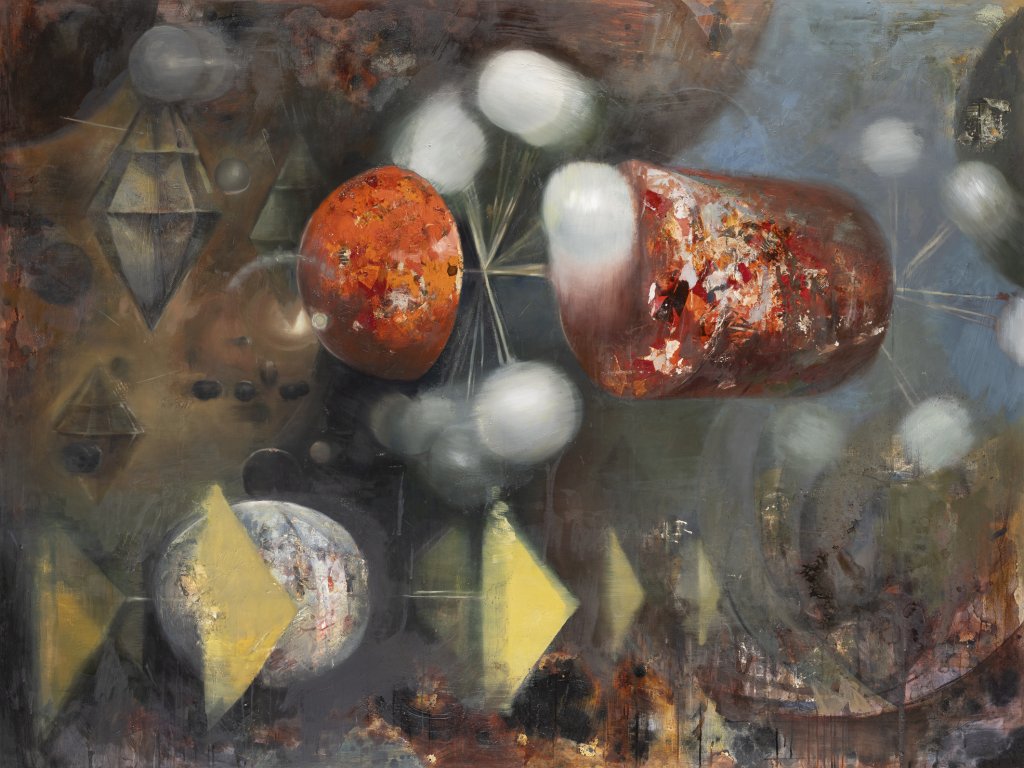
DANIEL BALABÁN

is a Czech painter and university teacher. His uncle was evangelical theologian and clergyman Milan Balabán and his brother was writer Jan Balabán. Since the mid-1980s he has been one of the leading artists of the Ostrava art scene and a coryphaeus of contemporary Czech art in general. He was born in the Moravian town of Šumperk, but has lived permanently in Ostrava since 1962. Between 1979 and 1984, he studied in the painting studio of Professor František Jiroudek at the Academy of Fine Arts in Prague, where he was habilitated in 2004. From 1993 to 2007 he worked as the head of the painting studio at the Department of Fine Arts at the University of Ostrava and since 2008 he has been the head of his painting studio at the Institute for Art Studies. Daniel Balabán is associated with the unpretentious, yet deeply spiritual position of the Czech painting tradition. He has an exklusive figurative handwriting, which he uses to return to themes that go beyond the limited horizon of everyday life – while elevating it to an almost metaphysical awe.
DANIEL PITÍN
studied classical painting and conceptual media at the Academy of Fine Arts in Prague (prof. Zdeněk Beran, prof. Miloš Šejn). Pitín creates visually complex paintings with dense symbolism and subtle references to canonic works of art, architecture, and late-modern aesthetics. His dark palettes, ethereal figures, and surreal structures – which both hide and reveal their actors – give his works a moodiness and a hint of unspoken content. He describes his paintings as fragments of stories and dreams through which he explores “the personal and collective memory of well-known places.” The principles behind his paintings are also found in his collages, videos, and films, which are characterized using found materials such as personal family and historical archives, online sources, and cinematic references, specifically the work of Alfred Hitchcock, film noir, and 1960s Czech cinema. One of his current works is presented in the exhibition, moving on the boundary between the recognizable and the object world, strongly accentuating the questions of the functioning of space-time and his own physical laws.

DANIEL FISCHER
studied at the Academy of Fine Arts in Bratislava (1968–1974, prof. Matejka). In 1992 he was appointed professor of painting. Between 1990–2017 he was the head of the studio at the Academy of Fine Arts in Bratislava. He has been a visiting professor in the USA (University of Tennessee, Knoxville, 1993; University of Pennsylvania, Slippery Rock, 1994; Rhode Island School of Design, 1998). He was or is a member of the Council of the State Fund of Culture for Slovakia, the Presidency of the Council of Universities, the director of the international exhibition of art school students IstroArt Biennial in Bratislava (1996), the chairman of the jury of the exhibition – triennial Contemporary Slovak Graphic Art (1998), etc. He was a member of the Association A–R (Advance-Retard). Daniel Fischer is one of the formative personalities of Central European painting, who has long developed the issue of the relationship between word/meaning and image in his work. He is a constructor of imaginative and conceptual worlds on the borderline of reality, set in a natural environment, which in this way becomes a sophisticated order of multiple degrees.
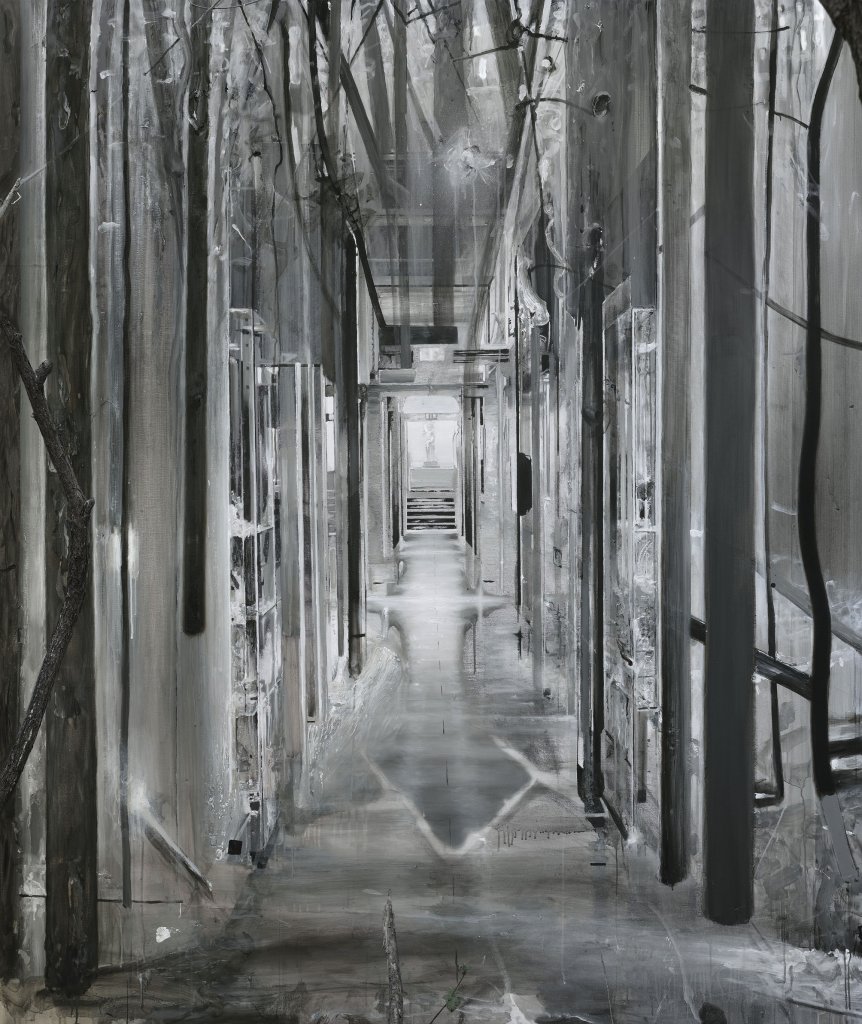
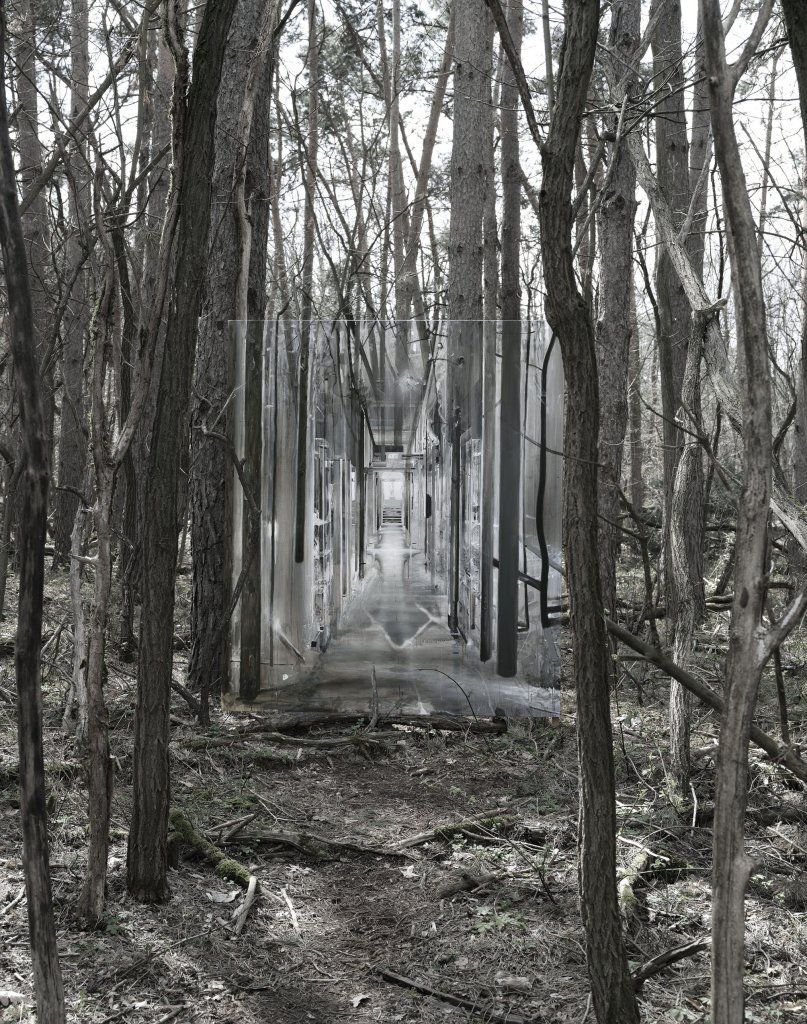
PETER ANGERMANN
studied at the Academy of Fine Arts in Nuremberg, then at the Kunstakademie in Düsseldorf in the studio of Joseph Beuys. After leaving the academy in 1972, he began to paint. A meeting with a former classmate, Milan Kunc, proved to be extremely fruitful. Together they developed a new visual language that was closely oriented towards everyday life, while emphasizing its inner contradictions or even humorous anarchy. In 1979, Jan Knap joined the two friends, and the NORMAL group was formed, thematizing, among other things, the exacerbated individualism of modern art. In 1981, the group disbanded. Peter Angermann remained faithful to his socially critical stance, developing portrait painting, plein air painting, and colourism. In addition, Angermann also works as a teacher (1996-2002 Städelschule in Frankfurt am Main, 2002-2010 Academy of Fine Arts in Nuremberg). The painting from the collections of the Olomouc Museum of Art can be classified within the framework of “cosmological studies” – it is an adventurous version of a self-portrait that uses the principle of so-called Klein’s bottle. The latter, like Möbius’s tape, represents a specific geometric shape, where the inside and outside cannot be distinguished – and is thus an excellent metaphor of our own relationship to the world, and vice versa.
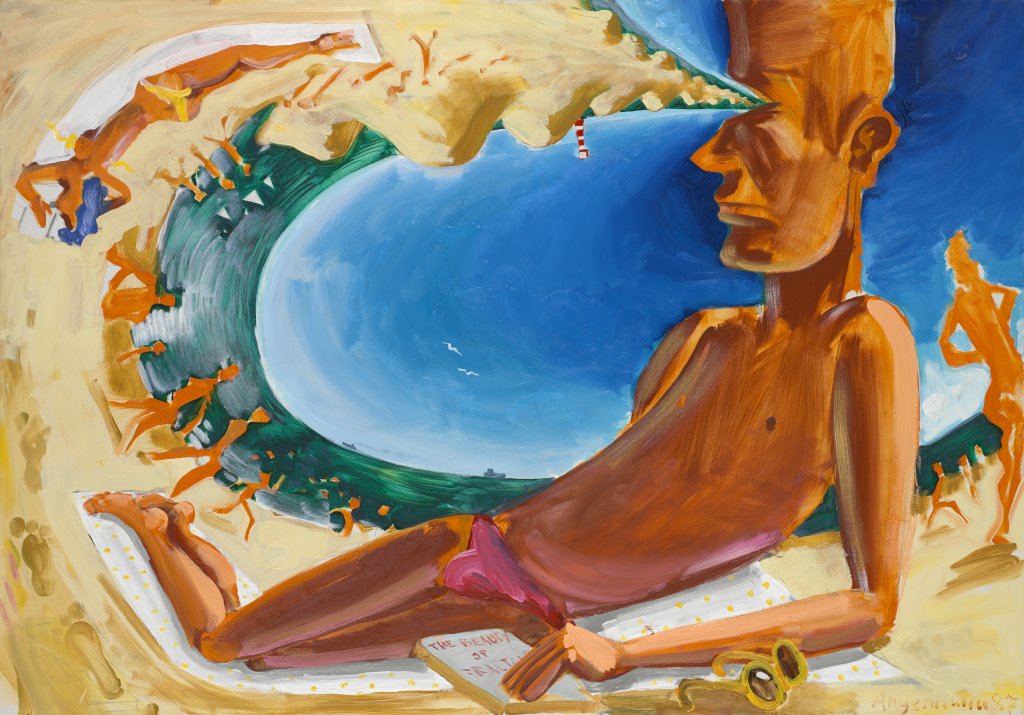
DANIEL FISCHER
studied at the Academy of Fine Arts in Bratislava (1968–1974, prof. Matejka). In 1992 he was appointed professor of painting. Between 1990–2017 he was the head of the studio at the Academy of Fine Arts in Bratislava. He has been a visiting professor in the USA (University of Tennessee, Knoxville, 1993; University of Pennsylvania, Slippery Rock, 1994; Rhode Island School of Design, 1998). He was or is a member of the Council of the State Fund of Culture for Slovakia, the Presidency of the Council of Universities, the director of the international exhibition of art school students IstroArt Biennial in Bratislava (1996), the chairman of the jury of the exhibition – triennial Contemporary Slovak Graphic Art (1998), etc. He was a member of the Association A–R (Advance-Retard). Daniel Fischer is one of the formative personalities of Central European painting, who has long developed the issue of the relationship between word/meaning and image in his work. He is a constructor of imaginative and conceptual worlds on the borderline of reality, set in a natural environment, which in this way becomes a sophisticated order of multiple degrees.


PETER ANGERMANN
studied at the Academy of Fine Arts in Nuremberg, then at the Kunstakademie in Düsseldorf in the studio of Joseph Beuys. After leaving the academy in 1972, he began to paint. A meeting with a former classmate, Milan Kunc, proved to be extremely fruitful. Together they developed a new visual language that was closely oriented towards everyday life, while emphasizing its inner contradictions or even humorous anarchy. In 1979, Jan Knap joined the two friends, and the NORMAL group was formed, thematizing, among other things, the exacerbated individualism of modern art. In 1981, the group disbanded. Peter Angermann remained faithful to his socially critical stance, developing portrait painting, plein air painting, and colourism. In addition, Angermann also works as a teacher (1996-2002 Städelschule in Frankfurt am Main, 2002-2010 Academy of Fine Arts in Nuremberg). The painting from the collections of the Olomouc Museum of Art can be classified within the framework of “cosmological studies” – it is an adventurous version of a self-portrait that uses the principle of so-called Klein’s bottle. The latter, like Möbius’s tape, represents a specific geometric shape, where the inside and outside cannot be distinguished – and is thus an excellent metaphor of our own relationship to the world, and vice versa.

LÁSZLÓ LAKNER
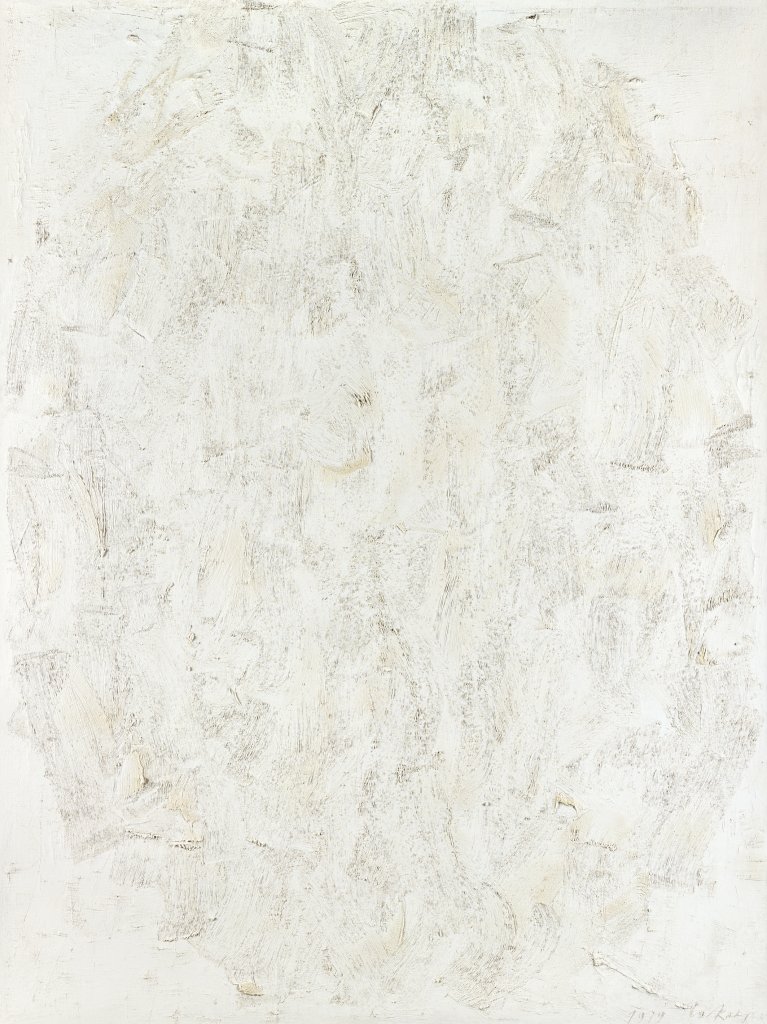
is one of the most important artists and actors of the Hungarian neo-avant-garde; since 1974 he has lived and worked in Berlin. He participated in the legendary Iparterv exhibitions that mark a milestone in Hungarian art history (1968, 1969), the Venice Biennale (1972, 1976, and 1990), and the Kassel Documenta (1977). His oeuvre is extensive, ranging from magical realism to combine painting and hyperrealism, to abstract painting and its conceptual approach. An important source of inspiration is print media, texts, illustrations, and photographs in newspapers and magazines. In Lakner’s multifaceted oeuvre themes of history, philosophy, poetry, and world events appear and materialise as a sensual form of painting. The permanent exhibition presents two works, examples of Lakner’s lifelong interest in the principles of art developed by Leonardo da Vinci and Marcel Duchamp.
DANUTA URBANOWICZ
studies of painting and sculpture at the Academy of Fine Arts Arts in Krakow (professors Jacek Puget, Adam Marczynski, Czeslaw Rzepinski and Jonas Stern). In 1956 she exhibited with the artists who later formed the Nowa Huta Group. Her artistic activity corresponded to the magazine Art Informel. In 1959–1962, she co-founded with a group of fellow artists and actors the avant-garde puppet theatre Widzimisie in Nowa Huta, an area of Kraków full of socialist architecture. She created her paintings and collages from various rough, poor, and shabby materials and objects. From 1961 she belonged to the Krakow Group. For the first and last period of her work she considered the problem of “paintings without painting”, i.e. structural painting. “In between” she conceptualized her expression. She experimented with photography, technical image and devoted herself to the problem of visual representation, which became more and more pressing with the advent of technological society – all the more so in the environment of a totalitarian society. It is in this context that we present it now – among other things as a parallel to Lakner’s own thinking.
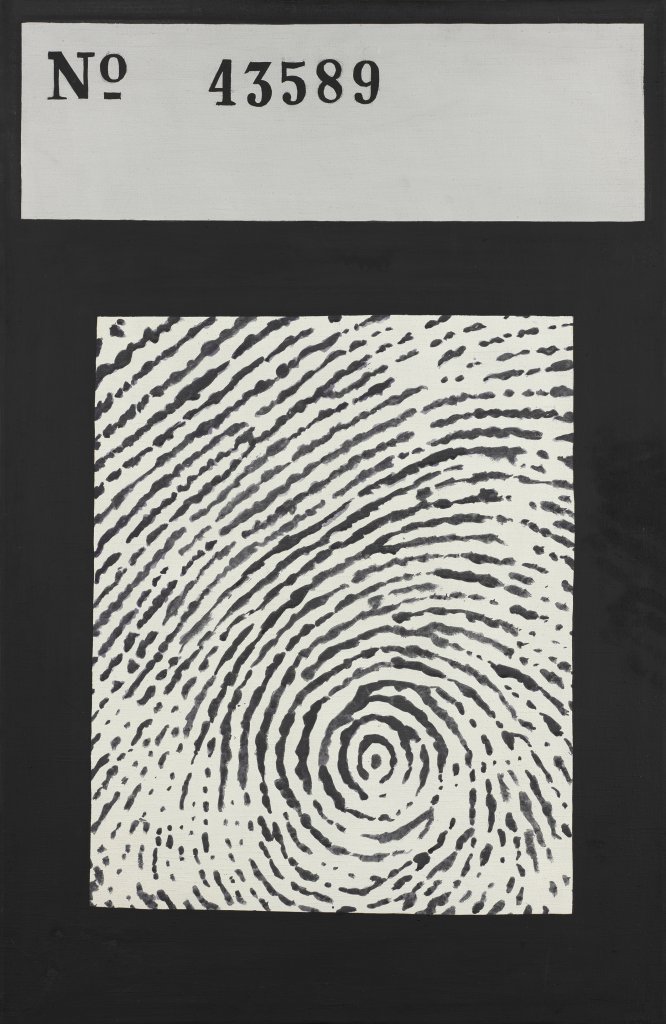
LÁSZLÓ LAKNER

is one of the most important artists and actors of the Hungarian neo-avant-garde; since 1974 he has lived and worked in Berlin. He participated in the legendary Iparterv exhibitions that mark a milestone in Hungarian art history (1968, 1969), the Venice Biennale (1972, 1976, and 1990), and the Kassel Documenta (1977). His oeuvre is extensive, ranging from magical realism to combine painting and hyperrealism, to abstract painting and its conceptual approach. An important source of inspiration is print media, texts, illustrations, and photographs in newspapers and magazines. In Lakner’s multifaceted oeuvre themes of history, philosophy, poetry, and world events appear and materialise as a sensual form of painting. The permanent exhibition presents two works, examples of Lakner’s lifelong interest in the principles of art developed by Leonardo da Vinci and Marcel Duchamp.
DANUTA URBANOWICZ
studies of painting and sculpture at the Academy of Fine Arts Arts in Krakow (professors Jacek Puget, Adam Marczynski, Czeslaw Rzepinski and Jonas Stern). In 1956 she exhibited with the artists who later formed the Nowa Huta Group. Her artistic activity corresponded to the magazine Art Informel. In 1959–1962, she co-founded with a group of fellow artists and actors the avant-garde puppet theatre Widzimisie in Nowa Huta, an area of Kraków full of socialist architecture. She created her paintings and collages from various rough, poor, and shabby materials and objects. From 1961 she belonged to the Krakow Group. For the first and last period of her work she considered the problem of “paintings without painting”, i.e. structural painting. “In between” she conceptualized her expression. She experimented with photography, technical image and devoted herself to the problem of visual representation, which became more and more pressing with the advent of technological society – all the more so in the environment of a totalitarian society. It is in this context that we present it now – among other things as a parallel to Lakner’s own thinking.
